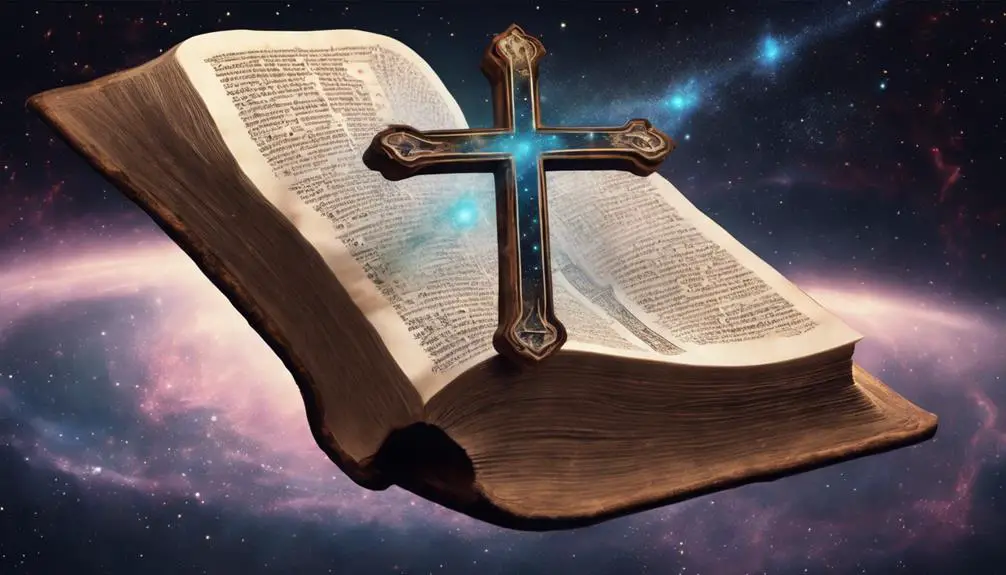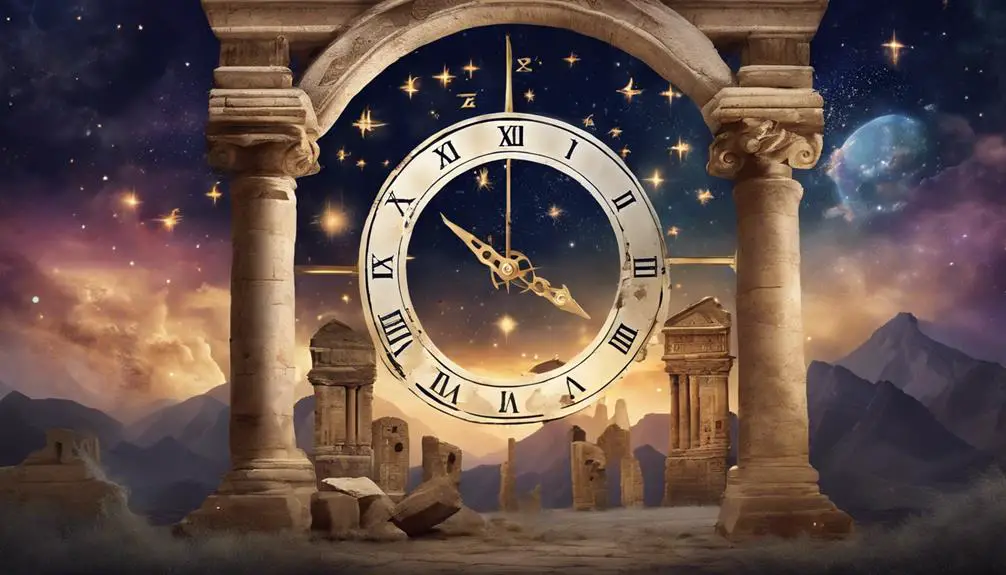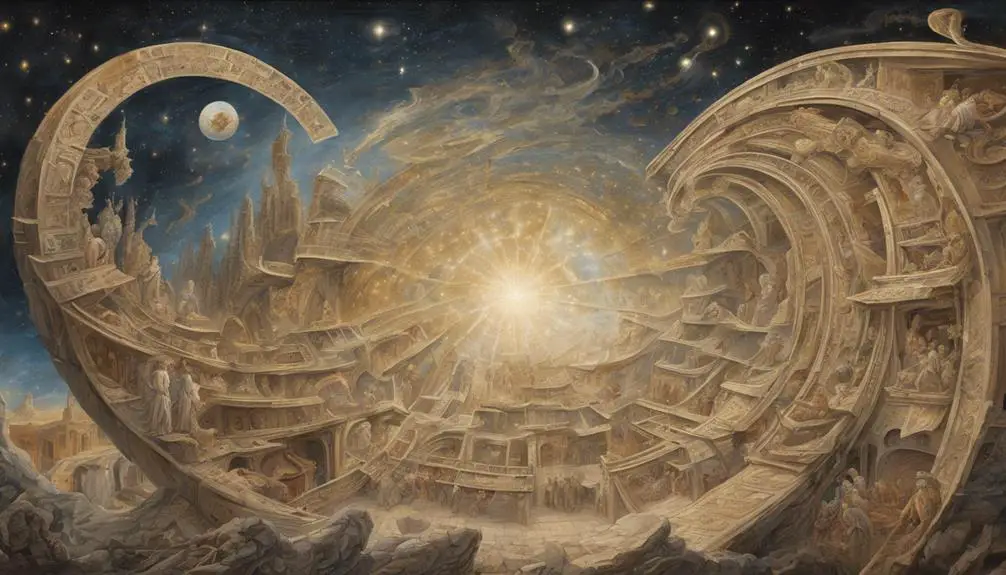Wander through the Bible's exploration of time, space, and matter, where divine mysteries unfold in the fabric of the universe.

Time Space and Matter in the Bible
Imagine you're standing at the edge of the Grand Canyon, its vastness stretching before you, a testament to the power of time, space, and matter. This image mirrors the Bible's treatment of these concepts, weaving them into narratives that span from the creation of the universe to the end times.
As you explore the Scriptures, you'll find that time marks moments of divine intervention, space defines sacred encounters, and matter binds the covenant between God and humanity. Yet, the deeper significance of these elements remains a mystery, inviting you to embark on a journey that intersects eternity with the here and now.
Key Takeaways
- The Bible presents time, space, and matter as intricately designed by divine intention.
- Sacred spaces and rituals in the Bible symbolize the intersection of divine presence with the physical realm.
- Biblical narratives use matter and elements to convey deeper spiritual truths and divine promises.
- Apocalyptic visions in the Bible utilize cosmic imagery to reveal the ultimate destiny of the universe.
The Genesis of Everything

In the beginning, the biblical narrative of Genesis presents a profound exploration of the origins of time, space, and matter, inviting you to ponder the foundational elements of existence. This scriptural passage isn't merely recounting the dawn of the physical universe; it's unveiling a complex tapestry of cosmic purpose interwoven with divine intervention. You're drawn into a reflective journey that transcends mere historical account; it's an invitation to discern the intricate relationship between the Creator and the creation.
Genesis doesn't just chronicle the advent of light, land, and life; it's a testament to the intentional act of bringing order from chaos. This divine intervention isn't depicted as a distant, impersonal force. Rather, it's an intimate act of shaping reality, imbuing it with purpose and potential. You're led to appreciate that this isn't about the mechanical workings of the cosmos but about a deliberate, thoughtful process aimed at fostering life and consciousness.
The narrative compels you to consider the implications of such origins. If time, space, and matter aren't random but born of purposeful divine action, then existence itself is anchored in meaning. This realization challenges you to rethink your place in the universe, urging a deeper understanding of your role in this grand design.
Thus, Genesis does more than narrate the beginning; it offers a lens through which to view the cosmos and our place within it. It suggests that behind the vast, impersonal expanses of the universe lies a cosmic purpose, a narrative of divine intervention that beckons you to find your own purpose within this majestic creation.
Chronology and Prophecy

Delving deeper into the biblical narrative, one finds that chronology and prophecy are intricately woven into the fabric of time, space, and matter, offering profound insights into the divine blueprint of history. The Bible isn't just a collection of spiritual teachings; it's a historical document that aligns prophetic accuracy with historical timelines, challenging you to reflect on the interconnectedness of divine foretelling and human history.
As you explore the prophetic books, you'll notice that prophecies aren't vague predictions but are tied to specific timelines, underscoring the precision with which the divine operates within the temporal realm. This alignment between prophecy and historical timelines serves as a testament to prophetic accuracy, inviting a deeper contemplation of the role of divinity in shaping human history.
The chronological details found in the Bible aren't mere historical markers; they're threads that connect prophecy to reality, demonstrating how prophetic visions have unfolded within the tangible framework of time and space. This interplay between prophecy and chronology isn't just about validating the authenticity of biblical narratives; it's about understanding the divine orchestration of history, where every moment and event is part of a larger, divinely authored story.
Reflecting on this intricate relationship, you're encouraged to see history not as a series of random occurrences but as a tapestry of divinely inspired moments, woven together with precision and purpose. The study of chronology and prophecy in the Bible thus becomes an exercise in recognizing the profound coherence and intentionality of the divine plan, offering insights that transcend the boundaries of time, space, and matter.
Sacred Spaces and Sanctuaries

How do sacred spaces and sanctuaries within the biblical narrative function as more than mere physical locations, serving instead as pivotal intersections of the divine and the human? These areas, delineated through sacred architecture and prescribed temple rituals, encapsulate the profound interaction between God and humanity. They're not just places of worship or historical interest; they're dynamic arenas where heaven and earth seem to converge, offering glimpses into the divine nature and purpose.
The architecture of these sacred spaces, meticulously detailed in biblical texts, doesn't merely serve an aesthetic or functional purpose. Instead, it symbolizes the cosmos, reflecting a divine order and harmony. The layout, materials, and construction of the Tabernacle and later the Temple in Jerusalem are imbued with theological significance, embodying the covenant relationship between God and His people. The design invites reflection, urging you to consider the cosmic scope of God's presence and promises.
Temple rituals, too, are far from being mere religious formalities. They represent the rhythm of divine-human interaction, encompassing sacrifices, festivals, and daily services that articulate themes of atonement, thanksgiving, and supplication. These practices provide a structured means by which individuals and the community as a whole can engage with the divine, acknowledging God's sovereignty while seeking forgiveness and blessing.
In essence, sacred spaces and sanctuaries within the biblical narrative serve as tangible expressions of an intangible reality. They're not just physical structures or routine rituals but are deeply embedded with spiritual significance, acting as conduits for divine revelation and human response.
Matter: Creation and Covenant

Exploring the biblical narrative reveals that matter, from the creation of the world to the establishment of the covenant, serves as a foundational element in understanding God's interaction with humanity. This material dimension, characterized by divine composition and elemental symbolism, reflects the intricate relationship between the Creator and creation. The physical substances of the earth aren't merely passive or inert; they're imbued with meaning and purpose, acting as vessels through which divine intentions and human responsibilities are communicated.
Consider the following aspects:
- Divine Composition: The Genesis account of creation illustrates matter being spoken into existence by God. This act underscores the belief that the material world, with its complexity and order, originates from a divine source. The narrative portrays matter as fundamentally good, crafted with intention and care, thereby establishing a cosmic order that reflects God's character and sovereignty.
- Elemental Symbolism: Throughout the Scriptures, elements such as water, fire, and earth carry profound symbolic meanings. Water, for instance, often represents life and purification, while fire can symbolize both God's presence and judgment. Earth, as the material from which humans were formed, signifies the intimate connection between humanity and the created world. These elements aren't mere backdrops in the biblical story but active participants that convey theological truths.
- Covenantal Significance: Material elements play a crucial role in the covenants God establishes with humanity. From the rainbow God sets as a sign of the Noahic covenant to the stone tablets of the Law in the Mosaic covenant, matter serves as a tangible witness to these divine promises. These physical signs remind humanity of God's faithfulness and their covenantal obligations.
Apocalyptic Visions and Realms

Building on the understanding of matter's role in biblical narratives, we now turn our attention to the depiction of apocalyptic visions and realms, which further illuminate the complex interplay between the physical and the divine. These narratives, rich with end time symbols and visionary metaphors, serve not merely as forecasts of doom but as profound reflections on the nature of reality, morality, and the ultimate destiny of the cosmos.
In these texts, you'll find a tapestry woven with symbols that are deeply rooted in the material world yet stretch far beyond its confines. Mountains burn with eternal fire, stars fall from the heavens, and beasts rise from the sea, embodying moral and spiritual truths in a language that speaks powerfully through its physicality. These end time symbols aren't just scare tactics or fantastical imagery; they're a language that bridges the gap between the seen and the unseen, the temporal and the eternal.
Visionary metaphors in apocalyptic literature serve a dual purpose: they critique the present by portraying it within the context of a cosmic drama and they offer a glimpse into potential futures, both dire and divine. This duality underscores the Bible's portrayal of time as cyclical and linear, moving towards a culmination that's both an end and a new beginning.
Through these apocalyptic visions, you're invited to ponder not just the end of all things but the nature of reality itself. They challenge you to see beyond the immediate, to question the material, and to consider the moral and spiritual dimensions of existence. In doing so, these texts offer a profound commentary on the human condition, situated within the broader cosmic narrative.
Intersecting Eternity With Now

In the realm of biblical narratives, the concept of eternity intersects with our temporal existence, challenging us to reconsider our understanding of time and its implications for our lives. The Bible, rich with stories and teachings, offers a unique lens through which we can explore the intersection of the eternal and the temporal. This intersection invites you to experience moments that transcend the ordinary, urging a deeper reflection on the nature of existence.
Eternal moments and transcendent experiences within the biblical context suggest that our typical perception of time may be limited. The scripture reveals three key ways in which eternity intersects with our present reality:
- Prophetic Fulfillment: Biblical prophecies often unfold within human history, yet they're rooted in an eternal purpose. This blending of timelines invites you to see beyond the immediate, recognizing the flow of divine intention through time.
- Sacred Encounters: Instances of divine intervention or revelation—such as Moses at the burning bush or Paul on the road to Damascus—serve as portals to the eternal. These moments, though fleeting, offer a glimpse into a reality beyond our temporal constraints.
- Spiritual Practices: Prayer, meditation, and other spiritual disciplines enable you to step outside of time, if only momentarily, to connect with the divine. These practices can open your heart and mind to the eternal, enriching your temporal existence with depth and meaning.
As you delve into the biblical narratives, you're invited to explore how these eternal moments and transcendent experiences can impact your understanding of time, space, and matter. Reflecting on these intersections can offer a profound sense of connection to the divine, weaving the eternal purpose into the fabric of your everyday life.
Frequently Asked Questions
How Does the Concept of Time in the Bible Align With Modern Scientific Understanding of Time and Space?
You'll find that the Bible's concept of time doesn't neatly align with modern scientific understandings, notably those shaped by Quantum theories and Relativity exploration.
While scripture often views time linearly and purposefully, science presents it as flexible and intertwined with space.
This divergence prompts deep reflection on the relationship between spiritual beliefs and empirical evidence, challenging you to consider how ancient texts and cutting-edge science can inform each other.
Can Biblical Descriptions of Matter and the Physical World Be Reconciled With Contemporary Physics and Cosmology?
You're diving into whether the Bible's take on matter and the cosmos aligns with modern physics. It's a complex interplay, where quantum theology and historical contexts shed light. You're navigating a path that blends ancient texts with cutting-edge science.
Reflectively, consider how historical interpretations of scripture have evolved alongside scientific discoveries. This exploration isn't just about reconciling differences but understanding how both perspectives contribute to a broader comprehension of the universe.
How Do Various Religious Traditions Interpret the Biblical Concepts of Time, Space, and Matter Differently?
You'll find that different religious traditions offer varied interpretations of universal concepts. By diving into cultural interpretations and considering the historical context, you're stepping into a rich tapestry of beliefs.
Each tradition brings its unique lens, reshaping how these abstract notions are understood. Reflecting on these diverse perspectives, it's clear that the analysis isn't just academic; it's a deeper inquiry into humanity's quest to grasp the infinite.
What Role Does Metaphor Play in the Biblical Depiction of Time, Space, and Matter, and How Should These Metaphors Be Understood Today?
Navigating the biblical landscape, you're wading through a sea of metaphorical language, especially when unpacking the essence of time, space, and matter.
These metaphors aren't just decorative; they're foundational, shaping your understanding of divine concepts. Yet, interpretation challenges loom large. You're tasked with discerning ancient meanings within a modern context—reflecting deeply, analyzing critically.
It's about finding relevance in these metaphors today, bridging millennia with thoughtful interpretation.
How Does the Biblical View of the Universe's Creation Influence Current Environmental Ethics and Our Responsibility Towards the Earth?
The biblical view of the universe's creation emphasizes your role in spiritual stewardship and ethical consumption. It suggests you're tasked with protecting the earth, reflecting on how your actions contribute to its well-being.
This perspective encourages you to engage in practices that honor the planet, advocating for a deeper consideration of how your lifestyle choices impact the environment. It's a call to action, urging you to embody principles that safeguard the earth's future.
Conclusion
In the tapestry of the Bible, you find time not as a mere sequence, but as a canvas for prophecy and divine appointments. Space transforms from physical sanctuaries to realms where the sacred and mundane merge.
Matter, once formless, becomes a testament to covenant and creation. These elements, juxtaposed, weave a narrative where the eternal intersects with the now, challenging you to reflect on the divine dance between the temporal and the timeless, the seen and the unseen.



Sign up